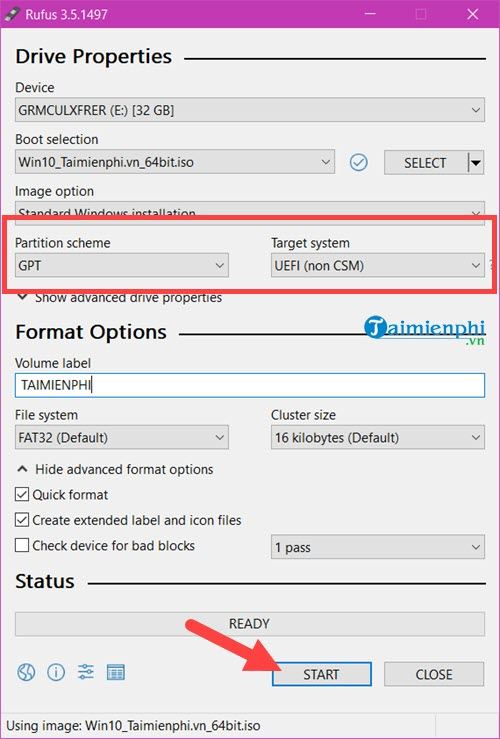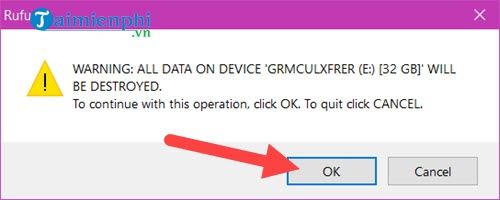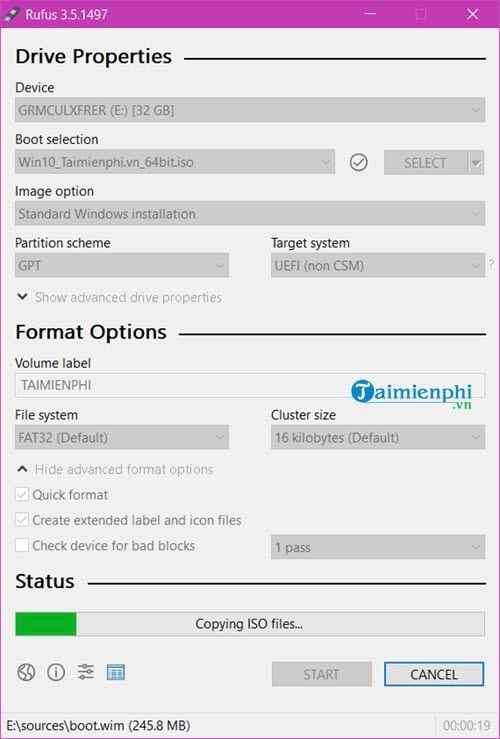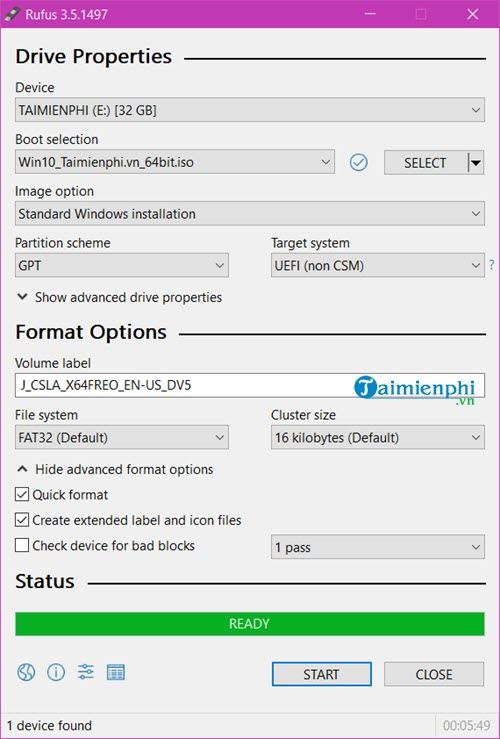How to create Windows 10 installation USB using Rufus, Boot UEFI and LEGACY
Rufus is considered one of the best Windows bootable USB creation tools today. With compact size and simple settings, it still ensures stability for Windows. Creating a Windows 10 bootable USB with Rufus is an extremely smart choice when you don't want to burn a Windows installation disc.
INSTRUCTIONS FOR CREATING USB BOOT WIN 10 USING RUFUS
1. Prepare
Before entering the step of creating a Windows 10 boot with Rufus, you need to prepare:
- 01 USB with a capacity of 4GB or more
- Rufus Windows boot usb creation tool: Download Rufus
- 01 Windows 10 operating system installation: Download Windows ten
2. Implementation
Step 1: Connect the USB you prepared to the computer, then launch Rufus.

Step 2: In the Device section , select the exact USB you want to create a Windows 10 boot USB with Rufus. Then select SELECT to navigate to the Windows 10 iso file you have prepared.

Step 3: Choose the appropriate version of Windows 10 that you want to boot. Then click Open to put the file into boot.

Step 4: Now in the Partition scheme section , depending on your computer standard, choose GPT or MBR . Then press Start. If you don't know what standard your computer follows, you can see the instructions to Check Windows uses UEFI or Legacy BIOS standard.

Step 5: Before decompressing, create a Windows 10 bootable USB with Rufus. The tool will display a dialog box warning that all data on your USB will be erased. You should back up important data on your USB then click OK to start the process.

Step 6: It will take some time for Rufus to boot Windows 10 onto your USB.

- When the word READY appears, creating a USB boot to install Windows 10 with Rufus is complete

Then you can use MobaLiveCD to check if the USB can be booted instead of having to reset the computer, which will take time.
Hope you install Windows 10 successfully!
You should read it
- How to create USB Boot, create a Windows installation USB with Rufus is simple and effective
- How to create USB Boot to install Windows 10 with Rufus
- 20 best USB boot software
- Rufus - The easiest USB boot creation application
- Fix ISO image extraction failure when creating USB Boot with Rufus
- How to create USB BOOT to install Windows 11 from standard ISO file using Rufus
- Instructions for creating Windows installation USB on both GPT and MBR standards with Rufus
- When do you need to create a USB Boot to install Windows using Rufus?
May be interested
- Steps to convert MRB to GPT drive structure in Windows 10
 in previous versions of windows, you were forced to reinstall the entire operating system if you wanted to convert from master boot record (mbr) (legacy bios) to guid partition table (gpt) (uefi).
in previous versions of windows, you were forced to reinstall the entire operating system if you wanted to convert from master boot record (mbr) (legacy bios) to guid partition table (gpt) (uefi). - Create USB Boot with 1 Click MultiBoot v5.0, Boot both UEFI and Legacy standards
 instructions on how to create usb boot multiboot full with 1 click multiboot v5.0, boot both uefi and legacy are extremely simple.
instructions on how to create usb boot multiboot full with 1 click multiboot v5.0, boot both uefi and legacy are extremely simple. - How to create USB Boot, create a Windows installation USB with Rufus is simple and effective
 with instructions on how to create usb boot, create usb to install windows for laptop through rufus software simple and effective with detailed steps, notes before implementation.
with instructions on how to create usb boot, create usb to install windows for laptop through rufus software simple and effective with detailed steps, notes before implementation. - What is UEFI and Legacy standards? Differences between UEFI, Legacy, BIOS
 you have known uefi, legacy bios, but those concepts are still very vague, you still do not understand exactly what is uefi and legacy? what is the difference between uefi, legacy bios? should we use uefi or legacy bios? the following article will gi
you have known uefi, legacy bios, but those concepts are still very vague, you still do not understand exactly what is uefi and legacy? what is the difference between uefi, legacy bios? should we use uefi or legacy bios? the following article will gi - How to create USB BOOT to install Windows 11 from standard ISO file using Rufus
 how to create windows 11 installation usb with rufus from iso file? how to install win 11 iso using usb boot, the latest operating system version from microsoft? if you don't know where to start or how to do it, please refer to the instructions on how to create a usb boot to install windows 11 with rufus from taimienphi's latest standard iso file.
how to create windows 11 installation usb with rufus from iso file? how to install win 11 iso using usb boot, the latest operating system version from microsoft? if you don't know where to start or how to do it, please refer to the instructions on how to create a usb boot to install windows 11 with rufus from taimienphi's latest standard iso file. - How to create USB Boot to install Windows 10 with Rufus
 creating a usb boot to install windows 10 with rufus is one of the simplest and most effective ways used by many people. however, if you do not know how to create a usb boot to install windows 10 with rufus, the article below tipsmake will guide you to do so. you can also apply it to creating a usb to install windows 11.
creating a usb boot to install windows 10 with rufus is one of the simplest and most effective ways used by many people. however, if you do not know how to create a usb boot to install windows 10 with rufus, the article below tipsmake will guide you to do so. you can also apply it to creating a usb to install windows 11. - 20 best USB boot software
 20 this usb boot software will help you create usb boot, usb install win quickly, easily, even can create usb boot containing many operating systems.
20 this usb boot software will help you create usb boot, usb install win quickly, easily, even can create usb boot containing many operating systems. - How to convert from Legacy to UEFI in BIOS
 legacy and uefi are two forms of software integrated into the motherboard that control certain aspects of the computer.
legacy and uefi are two forms of software integrated into the motherboard that control certain aspects of the computer. - Fix ISO image extraction failure when creating USB Boot with Rufus
 when you perform usb boot with rufus software to install windows or other software will appear an error message error: iso image extraction failure.
when you perform usb boot with rufus software to install windows or other software will appear an error message error: iso image extraction failure. - Common errors when using Rufus and the simplest and most effective ways to fix them
 rufus is an application that helps users format usb and create a windows installation drive. during the process of installing and using rufus, errors are inevitable. if you are encountering a rufus error and don't know how to fix it, you can refer to the instructions in the article below and follow the steps.
rufus is an application that helps users format usb and create a windows installation drive. during the process of installing and using rufus, errors are inevitable. if you are encountering a rufus error and don't know how to fix it, you can refer to the instructions in the article below and follow the steps.










 Shortcut key combination for Windows laptop, Macbook
Shortcut key combination for Windows laptop, Macbook How to update the latest Windows 10 21H1 for laptops and PCs
How to update the latest Windows 10 21H1 for laptops and PCs How to turn off the computer quickly with the keyboard on Windows 10, 8, 7
How to turn off the computer quickly with the keyboard on Windows 10, 8, 7 What are Device Management and Mobile Device Management (MDM)?
What are Device Management and Mobile Device Management (MDM)? How to increase PC volume, amplify sound, increase computer and laptop speakers
How to increase PC volume, amplify sound, increase computer and laptop speakers How to create a standard USB BOOT to install Windows 10 on both UEFI and LEGACY
How to create a standard USB BOOT to install Windows 10 on both UEFI and LEGACY